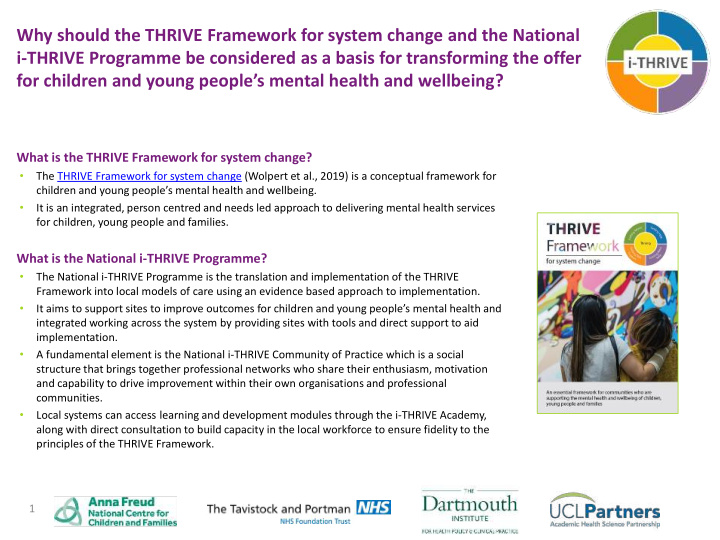



Why should the THRIVE Framework for system change and the National i-THRIVE Programme be considered as a basis for transforming the offer for children and young people’s mental health and wellbeing ? What is the THRIVE Framework for system change? • The THRIVE Framework for system change (Wolpert et al., 2019) is a conceptual framework for children and young people’s mental health and wellbeing. • It is an integrated, person centred and needs led approach to delivering mental health services for children, young people and families. What is the National i-THRIVE Programme? • The National i-THRIVE Programme is the translation and implementation of the THRIVE Framework into local models of care using an evidence based approach to implementation. • It aims to support sites to improve outcomes for children and young people’s mental health and integrated working across the system by providing sites with tools and direct support to aid implementation. • A fundamental element is the National i-THRIVE Community of Practice which is a social structure that brings together professional networks who share their enthusiasm, motivation and capability to drive improvement within their own organisations and professional communities. • Local systems can access learning and development modules through the i-THRIVE Academy, along with direct consultation to build capacity in the local workforce to ensure fidelity to the principles of the THRIVE Framework. 1
Why should the THRIVE Framework for system change and the National i-THRIVE Programme be considered as a basis for transforming the offer for children and young people’s mental health and wellbeing ? How are the THRIVE Framework and the National i-THRIVE Programme aligned to key NHS policies for children and young people’s mental health and wellbeing ? Who has already begun to implement the THRIVE Framework through the National i-THRIVE Programme? • At April 2019, 99 CCG areas within England were part of the National i-THRIVE Community of Practice – a collection of local sites sharing learning about the implementation of the THRIVE Framework. • This equates to 62% of the children and young people population of England. 2
Why should the THRIVE Framework for system change and the National i-THRIVE Programme be considered as a basis for transforming the offer for children and young people’s mental health and wellbeing ? What are the key expected outcomes of implementing the THRIVE Framework locally? • Children, young people and families feel more involved in decision making about their help and support and are more empowered to manage their own mental health and make the best use of the resources available. • Improvement in access to appropriate mental health help and support, reduction in waiting times for specialist mental health and wellbeing services and increased engagement and attendance across the system with greater opportunities for support to be provided within the community where appropriate and preferred. • Professionals working to support children, young people and families report more positive experience of partnership working and reduction in children and young people passed from one place to the other via interagency referrals through a greater interagency understanding and vision. What benefits have sites that are implementing the THRIVE Framework already identified? • There are over 30 i-THRIVE Implementation Stories published on the i-THRIVE website that set out examples of successful implementation to date. • Benefits identified by individual sites have included: o improved interagency working and collaboration o increased shared decision making with children and young people o a wider and more diverse offer of help and support for children and young people across the system o reduction in waiting times for specialist services o increased collaboration with young people as part of service redesign If you are interested in finding out more about how the THRIVE Framework or the National i-THRIVE Programme could support you locally please contact Bethan Morris at bmorris@tavi-port.nhs.uk or visit: www.implementingthrive.org. 3
Why engage with the National i-THRIVE Programme to support implementation of the THRIVE Framework for system change? If a local site intends to use the THRIVE Framework for system change (Wolpert et al., 2019), as the framework for their children and young people’s mental health and wellbeing offer, the National i-THRIVE Programme can support sites in implementing this. How can the National i-THRIVE Programme support a local site with the implementation of the THRIVE Framework? 4
Why engage with the National i-THRIVE Programme to support implementation of the THRIVE Framework for system change? How can the National i-THRIVE Programme support a local site with the implementation of the THRIVE Framework? Continued… 5
Expected outcomes of implementing the THRIVE Framework for system change What impact do we expect through implementation of the THRIVE Framework? • Improve functioning and life chances of all children, young people and families in the area • Children, young people and families more empowered to manage their own mental health and make the best use of the resources available, including managing any ongoing mental health issues • Children, young people and families feel more involved in decision making about their help and support • Children and young people’s mental health needs identified earlier and appropriately responded to earlier • Professionals working to support children, young people and families report more positive experience of partnership working • Improvement in access to appropriate mental health help and support: reduction in waiting times for specialist mental health and wellbeing help across the system e.g. fewer inappropriate referrals and discharges • Increased engagement and attendance across the system with greater opportunities for support to be provided within the community where appropriate and preferred • Reduction in children and young people passed from one place to the other via interagency referrals through a greater interagency understanding and vision of what can be helpful in supporting children and young people’s mental health and wellbeing • Greater openness and a shared understanding about when to end help • Shared outcomes framework understood by all 6
Recommend
More recommend